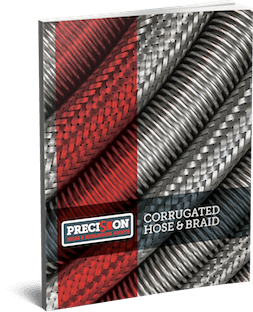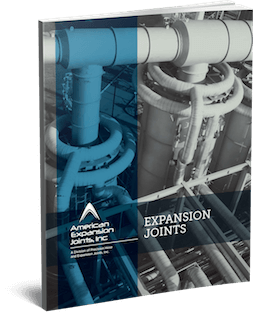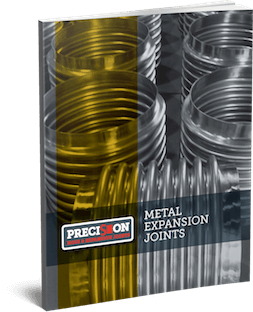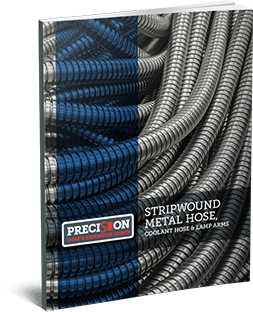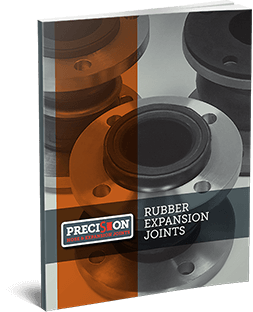HOSE & EXPANSION JOINT GLOSSARY
Bellows-
The flexible element of an Expansion Joint consisting of one or more convolutions.
Control Rods-
Devices, usually in the form of rods or bars, attached to the Expansion Joint assembly whose primary function is to distribute the movement between the two bellows of a universal expansion joint. Control rods are not designed to restrain bellows pressure thrust.
Cover-
A device used to provide limited protection of the exterior surface of the bellows of an expansion joint from foreign objects or mechanical damage. A cover is sometimes referred to as a shroud.
Convolution-
The smallest flexible unit of a bellows. The total movement capacity of a bellows is proportional to the number of convolutions.
Equalizing and Reinforcing Rings-
Devices used on some expansion joints fitting snugly in the roots of the convolutions. The primary purpose of these devices is to reinforce the bellows against internal pressure.
Equalizing rings are made of cast iron, steel, stainless steel, or other suitable alloys and are approximately “T” shaped in cross-section. Reinforcing or root rings are fabricated from tubing or solid round bars of carbon steel, stainless steel, or other suitable alloys.
Flanged Ends-
The ends of an expansion joint equipped with flanges for the purpose of bolting the expansion joint to the mating flanges of adjacent equipment or piping.
Internal Sleeve-
A device that minimizes contact between the inner surface of the bellows of an expansion joint and the fluid flowing through it. These devices have also been referred to as liners or baffles.
Limit Rods-
Devices, usually in the form of rods or bars, attached to the expansion joint assembly whose primary function is to restrict the bellows movement range (axial, lateral, and angular) during normal operation. In the event of a main anchor failure, they are designed to prevent bellows over-extension or over-compression while restraining the full pressure loading and dynamic forces generated by the anchor failure.
Purge Connections-
Purge connections, where required, are usually installed at the sealed end of each internal sleeve of an expansion joint for the purpose of injecting a liquid or gas between the bellows and the internal sleeve to keep the area clear of erosive and corrosive media and/or solids that could pack the convolutions. Purging may be continuous, intermittent, or just on start-up or shut down, as required. These are sometimes called aeration connections.
Shipping Devices-
Rigid support devices installed on an expansion joint to maintain the overall length of the assembly for shipment. These devices may also be used to precompress, pre-extend or laterally offset the bellows. They should not be used to resist pressure thrust during testing.
Slotted Hinges-
Devices installed as diametrically opposed pairs on an Expansion Joint permitting axial and one plane angular movement. Slotted hinges can be designed to perform as control devices, distributing movements between two bellows of a universal Expansion Joint but do not restrain pressure thrust. They may also be designed as limiting devices, restricting the bellows movement range and can restrain the full pressure loading and dynamic forces generated by
an anchor failure. These devices can be used to transmit extraneous loads and forces, such as system dead weight, wind, and seismic loads transverse to the Expansion Joint axis, rather than across the flexible bellows element.
Stabilizer-
A device, internally or externally attached to the Expansion Joint assembly, whose primary function is to increase the stability of a universal Expansion Joint assembly.
Tangents-
The straight un-convoluted portions at the end of the bellows.
Tangent Reinforcement-
A reinforcing member located around the circumference of the bellows tangent for the purpose of reducing excessive pressure stresses which could lead to circumferential yielding.
Tie Rods-
Devices, usually in the form of rods, or bars, attached to the expansion joint assembly whose primary function is to continuously restrain the full bellows pressure thrust during normal operation while permitting only lateral deflection. Angular rotation can be accommodated only if two tie rods are use and located 90˚ as opposed to the direction of rotation.
Weld Ends-
The ends of an expansion joint equipped with pipe suitably beveled for welding to adjacent equipment or piping.
CONTROL UNIT DEFINITIONS
Abrasion Resistance: The ability to withstand the wearing effect of a rubbing surface. In elastomers, abrasion is a complicated process, often affected more by compounding and curing than by the elastomer. Soft, resilient compounds, such as pure gum rubber are frequently specified.
Ambient Temperature: The environment temperature surrounding the object under construction.
Anchor: Terminal point or fixed point in a piping system from which directional movement occurs.
Angular Movement: The movement which occurs when one flange of the expansion joint is moved to an out of parallel position with the other flange. Such movement is measured in degrees.
Arch: The portion of an expansion joint which accommodates the movement of the joint.
Atmospheric Cracking: Cracks produced on the surface of rubber articles by exposure to atmospheric conditions, especially sunlight, ozone and pollution. Chlorobutyl, EPDM, Neoprene, and Fluoroelastomers are all highly resistant compounds.
Axial Compression: The dimensional reduction or shortening in the Face to Face parallel length of the joint measured along the longitudinal axis.
Axial Elongation: The dimensional increase or lengthening in the Face to Face parallel length of the joint measured along the longitudinal axis.
Axial Extension: The dimensional lengthening of an expansion joint parallel to its longitudinal axis. Such movement is measured in inches or millimeters. See Axial Elongation
Back-up Rings: See Retaining Rings
Bellows: See Arch or Expansion Joint
Blister: A raised spot on the surface or a separation between layers, usually forming a void or air-filled space in the rubber article.
Bloom: A natural discoloration or change in the appearance of a surface of the rubber product caused by the migration of a liquid or solid to the surface. Examples: sulfur bloom, wax bloom. Not to be confused with dust on the sur- face from external sources.
Body: The body consists of the Cover, Carcass and Tube. Body Rings: See Metal Reinforcement
Bolt Hole Pattern or Drill Pattern: The systematic location of bolt holes in the expansion joint flanges where the joint is to be bolted to mating flanges.
Bore: A fluid passageway, normally the inside diameter of the expansion joint.
Burst Test: A test to measure the pressure at which an expansion joint bursts.
Carcass: The carcass or body of the expansion joint consist of fabric and, when necessary, metal reinforcement. See Body
Chalking: Formation of a powdery surface condition due to disintegration of surface binder or elastomer, due in turn to weathering or other destructive environments.
Compression Set: The deformation which remains in rubber after it has been subjected to and released from a specific compressive stress for a definite period of time, at a prescribed temperature.
Concurrent Movements: Combination of two or more types of movement.
Conductive: A rubber having the qualities of conducting or transmitting heat or electricity. Most, generally applied to rubber products capable of conducting static electricity.
Control Rods or Units: Devices usually in the form of tie rods, attached to the expansion joint assembly whose primary function is to restrict the bellows axial movement range during normal operation. In the event of a main anchor failure, they are designed to prevent bellows over-extension or over-compression while absorbing the static pressure thrust at the expansion joint, generated by the anchor failure. The definition of “Control Rods”, when used in reference to rubber expansion joints, differs from when used in reference to metal expansion joints. The definition above is the definition when used in reference to rubber expansion joints.
Convolution: See Arch
Cover: The exterior surface of the joint is formed from natural or synthetic rubber, depending on service requirements. The prime function of the cover is to protect the carcass from outside damage or abuse. Special polymers can be supplied to resist chemicals, oils, sunlight, acid fumes, and ozone. Also, a protective coating may be applied to the exterior of the joint for additional protection. The definition of a metal expansion joint “cover” is totally different and should not be confused with the definition of a rubber expansion joint “cover” defined above.
Cracking: See Atmospheric Cracking, Flex Cracking
Crazing: See Atmospheric Cracking
Cycle Life: One full movement cycle is defined as the sum of the total movements incurred when an expansion joint fully compresses from the neutral position then moves to the position of the maximum allowed elongation and finally returns to neutral. Cycle life depends not only on the amount of movement but also on the frequency of cycles or cycle rate. Cycle life can also be affected by installation practices, temperature, and type of media being handled.
Design Pressure: The maximum high temperature that the expansion joint is designed to handle during normal operating conditions. Not to be confused with excursion temperature.
Diameter Inside: The length of a straight line through the geometric center and terminating at the inner periphery of an expansion joint.
Directional Anchor: A directional or sliding anchor is one that is designed to absorb loading in one direction while permitting motion in another. It may be either a main or intermediate anchor, depending upon the application involved. When designed for the purpose, a directional anchor may also function as a pipe alignment guide.
Direct Shear: See Lateral Deflection
Drill Pattern: The systematic location of bolt holes on the mating flange to which the expansion joint will be attached. Usually meets a specific specification.
Durometer: A measurement of the hardness of rubber. See Hardness
Eccentricity: A condition in which the inside and outside of two diameters deviate from a common center.
Electrical Resistivity: The resistance between opposite parallel faces of material having a unit length and unit cross-section. Typically measured in ohms/cm.
Elongation: Increase in length expressed numerically as a fraction or a percentage of initial length.
Enlarged End: An end with an inside diameter greater than that of the main body of an expansion joint.
Expansion Joint: Any device containing one or more bellows used to absorb dimensional changes, such as those caused by thermal expansion or contraction of a pipeline, duct, or vessel.
Fabric Reinforcement: The carcass fabric reinforcement is the flexible and supporting member between the tube and cover. Standard constructions normally utilize high-quality synthetic fabric. Natural fabrics can also be used at some pressures and temperatures. All fabrics are impregnated with rubber or synthetic compounds to permit flexibility between the fabric plies.
Face to Face: Dimension between the pipe flange faces to which the expansion joint will be bolted. This is also the length of the expansion joint when the system is in the cold position. See Pre-compression and Pre-set.
Filled Arch: Arch-type expansion joints may be supplied with a bonded-in-place soft rubber filler to provide a smooth interior bore. Filled arch joints also have a seamless tube so the arch filler cannot be dislodged during service. Filled arches, built as an integral part of the carcass, decrease the flexibility of the joint and should be used only when necessary. Movements of expansion joints with filled arches are limited to 50% of the normal movements of comparable size expansion joints with unfilled (open) arches.
Flex Cracking: A surface cracking induced by repeated bending or flexing.
Floating Flange: A metal flange that is grooved to contain the bead on each end of the expansion joint. The flange floats until lined up with mating bolt holes and bolted in place, and is used on spherical expansion joints.
Hardness: Property or extent of being hard. Measured by the extent of the failure of the indenter point of any one of a number of standard hardness testing instruments to penetrate the product. See Durometer
Heat Resistance: The ability of rubber articles to resist the deteriorating effects of elevated temperatures.
Hydrostatic Test: Hydrostatic pressure testing involves filling the expansion joint with a liquid, usually potable water. After the expansion joint is filled it can then be pressurized to the required test pressure. If required, joints can be hydrostatically tested up to 1.5 times the maximum allowable working pressure of the product, for a minimum of 10 minutes without leaks.
Installed Length: See Face to Face
Lateral Deflection: The relative displacement of the two ends of an expansion joint perpendicular to its longitudinal axis. This has been referred to as lateral offset, lateral movement, parallel misalignment, direct shear, or transverse movement.
Lateral Movement: See Lateral Deflection
Lateral Offset: See Lateral Deflection
Limit Rods: See Control Units The definition of “Limit Rods” when used in reference to rubber expansion joints differs from when used in reference to metal expansion joints.
Main Anchor: The main anchor is one which must withstand all of the thrust due to pressure, flow, and spring forces of the system.
Maximum Burst: Is the theoretical (predetermined) burst pressure of an expansion joint.
Metal Reinforcement: Wire or solid steel rings embedded in the carcass are frequently used as strengthening members of the joint. The use of metal some- times raises the rated working pressure and can supply rigidity to the joint for vacuum service.
Misalignment: The out-of-line condition that exists between the adjacent faces of the flanges.
Movements: The dimensional changes which the expansion joint is designed to absorb, such as those resulting from thermal expansion or contraction. See Angular Movement, Concurrent Movement, Resultant Movement, Lateral Movement, Torsional Movement, Thermal Movement, Transverse Movement.
OAL: Alternative term for the Face to Face dimension of the overall length of an expansion joint.
Oil Resistant: The ability to withstand the deteriorating effects of oil (generally refers to petroleum) on physical properties.
Oil Swell: The change in the volume of rubber due to absorption of oil.
Open Arch: The Arch or the Convolution is not filled it is open with no filler. The opposite of Open Arch is Filled Arch. See Filled Arch
Operating Temperature: The temperature at which the system will generally operate during normal conditions.
Parallel Misalignment: See Lateral Deflection
Permeability: The ability of a fluid or gas to pass through an elastomer.
Permanent Set: Permanent set is the deformation remaining after a specimen has been stressed in tension or compression a prescribed amount for a definite period and released for a definite period.
Ply: One concentric layer or ring of material, such as fabric plies in an expansion joint.
Pre-Compression: Compressing the expansion joint (shortening the Face to Face) so that in the cold position the joint has a given amount of compression set in the joint. The purpose of pre-compression is to allow for unexpected or additional axial extension. This is performed at the job site.
Pre-Set: Dimension that joints are deflected to insure that desired movements will take place. See Lateral.
Proof Pressure Test: See Hydrostatic Test
Reinforcing Rings: Metal reinforcing rings in steel, stainless steel, Monel, or other metals may be used to add strength between the Convolutions or Arches.
Reinforcement: See Carcass
Resultant Movement: The net effect of concurrent movement.
Retaining Rings: Split metal retaining rings are installed directly against the back of the flanges of the joint and bolted through to the mating flange of the pipe.
Root Ring: See Reinforcing Rings
Spool “Arch” Type: A full-face integral flange is available in both single arch and multiple arch types. Construction is of fabric and rubber, reinforced with metal rings or wire. The full face flanges are integral with the body of the joint and drilled to conform to the bolt pattern of the companion metal flanges of the pipeline. This type of rubber face flange is of sufficient thickness to form a tight seal against the metal flanges without the use of gaskets.
Sun Checking: See Atmospheric Cracking
Thermal Movements: Movements created within the piping system by thermal expansion. Can be Axial, Lateral, or Torsional.
Torsional Movement: The twisting of one end of an expansion joint with respect to the other end about its longitudinal axis. Such movement is measured in degrees.
Transverse Movement: See Lateral Deflection
Tube: A protective, leak-proof lining made of synthetic or natural rubber as the service dictates. This is a seamless tube that extends through the bore to the outside edges of the flanges. Its purpose is to eliminate the possibility of the materials being handled penetrating the carcass and weakening the fabric. These tubes can be designed to cover service conditions for chemical, petroleum, sewage, gaseous and abrasive materials.
Wide Arch: This type, similar to the Narrow “Arch” Type, is available in a metallic reinforced and non-metallic reinforced design. Generally, the Wide Arch Type features greater movements than the standard spool “Arch” Type
Wire Reinforced: A product containing metal wire to give added strength, increased dimensional stability, or crush resistance. See Reinforcement.
Wrap Marks: Impressions left on the cover surface by the material used to wrap the expansion joint during vulcanization. Usually shows characteristics of a woven pattern and wrapper width edge marks.
Van Stone Flange: A loose, rotating type flange, sometimes called a lap-joint flange.

